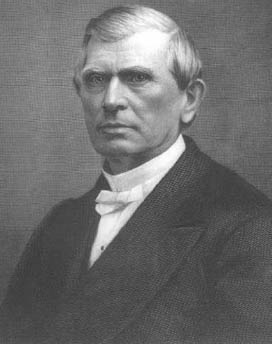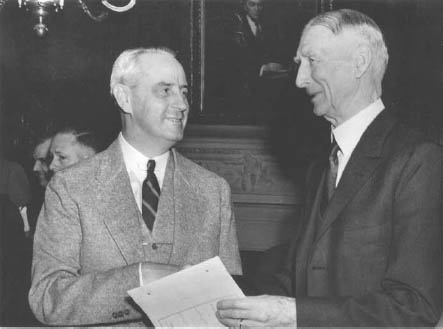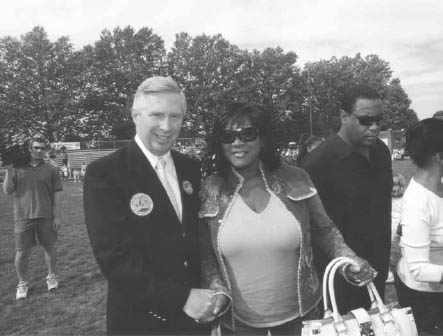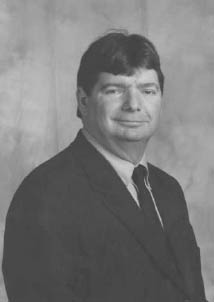Remembering Conshohocken and West Conshohocken (18 page)
Read Remembering Conshohocken and West Conshohocken Online
Authors: Jack Coll

Carroll Meyers was employed by the Schuylkill Iron Works and spent a few days touring the borough, checking in on the condition of employees. When he checked on an employee on Old Elm Street, he found the father and son very ill in bed, unable to care for themselves. The mother and daughter had died of the flu a week earlier. Both men were removed to the hospital, where they recovered. Had it not been for Meyers, they would have certainly died.
All residents traveling outdoors were asked to wear masks over their faces, and residents who had an ill family member were forced to hang a black scarf across their front door, warning potential visitors to stay away.
The influenza epidemic was gone as quickly as it started. When it was all over, seventy-eight Conshohocken residents lost their lives to the flu, ten West Conshohocken residents died and another forty-two residents passed away from the flu in Plymouth and Whitemarsh Townships.
The Conshohocken Calvary Church Hospital opened on October 12, 1918, and remained in service until October 29, 1918. Dozens of borough volunteers risked their lives to save hundreds of borough residents. Conshohocken had never had a hospital before the influenza outbreak, nor has it had one since.
When the schoolchildren were permitted to return to school later in the year, they would often play in the schoolyard, and the young girls would skip rope in rhyme with:
I had a little bird
,
Its name was Enza
.
I Opened the window
,
And in-flu-enza
.
ISHOP
M
ATTHEW
S
IMPSON
,
THE
P
RESIDENT AND
C
ONSHOHOCKEN
Matthew Simpson was a Methodist bishop of Philadelphia who became very good friends with President Abraham Lincoln. The president would often summon Bishop Simpson to the White House for his opinion on important matters, stating that the bishop was more in touch with the common American and would understand the reaction to the situation, helping Lincoln to make decisions.

Bishop Matthew Simpson of Philadelphia visited Conshohocken in 1867 to help lay the cornerstone at the newly formed United Methodist Church being built on the corner of Elm and Fayette Streets. History tells us that Bishop Simpson was good friends with President Abraham Lincoln, and following Lincoln's assassination, Simpson gave what was called the “Great Eulogy” at Lincoln's graveside in Springfield, Illinois.
When President Lincoln was assassinated, his body traveled across parts of the country to his final resting place in Springfield, Illinois. On May 4, 1865, Bishop Matthew Simpson stood at Lincoln's graveside and gave what was described in history as the “Great Eulogy.” And a great eulogy it was. The twenty-page document, found in the Abraham Lincoln Presidential Library, states in part, “Abraham Lincoln was a good man. He was known as an honest, temperate, forgiving man; a just man; a man of noble heart in every way.” Thousands of mourners as far as the eye could see stood at the grave site, and not a dry eye was to be seen.
Stephen Miller of Conshohocken was an enlisted man in the Northern forces stationed in Washington, D.C., when Lincoln was assassinated. Miller was selected as a member of the Honor Guard in the president's funeral procession and was at the graveside when Bishop Simpson brought tears to the nation with his speech.
Just two years later, Stephen Miller and Bishop Simpson crossed paths once more when Bishop Simpson came to Conshohocken to lay the cornerstone and dedicate the founding of the Conshohocken United Methodist Church, built at the corner of Elm and Fayette Streets. Once again, Bishop Simpson gave a speech to the more than one hundred townsfolk in attendance before going back to Philadelphia.
HAT
'
S
R
IGHT
, O
WNER OF THE
P
HILADELPHIA
P
HILLIES
William Baker owned the Philadelphia Phillies in the early part of the last century, and when he passed away in 1930, he left the team to his nephew, Gerald Nugent. Nugent was a Conshohocken resident for many years and lived on upper Fayette Street. Nugent ran into financial problems and was forced to sell the team back to the league in 1942. Nugent and his wife, Mae, and son Gerald Jr. lived in Conshohocken during his ownership of the Philadelphia team. Nugent's financial problems stemmed from the fact that he could never get more than three thousand fans into the ballpark at the Baker Bowl or Shibe Park.
Nugent owned the team during the midst of one of the longest streaks of futility in baseball history. From 1918 to 1947, the Phillies would have only one winning seasonâin 1932, when they posted a 78-76 recordâand only finished higher than sixth place twice.

A little-known fact about one of Conshohocken's residents is that the one-time owner of the Philadelphia Phillies baseball club lived on Fayette Street. Gerald Nugent lived with his wife, Mae, and son, Gerald Jr., when he owned the Phillies from 1933 until 1942, when he was forced to sell the team back to the league due to financial problems. Nugent's teams never posted a winning record. Nugent is seen chatting with former Philadelphia As owner and manager Connie Mack.
UST A
F
EW
M
ORE
N
AMES
“Chuck Wagon Pete,” “Pete's Gang,” “Uncle Pete.” Francis X. Boyle was known to thousands of Philadelphia children for his television shows, where he made friends with the animals, drew many of his characters and displayed the most popular cartoons of the day. His shows ran from 1947, when he started with a show called
Chalk Talk
, until he passed away in 1967.
Peter Boyle lived on the 400 block of East Eleventh Avenue in Conshohocken for a number of years and would often lead the soapbox derby parade up Fayette Street on July Fourth. Peter's son, Peter Jr., went on to star in many movies and television roles, such as Frankenstein and the father on
Everybody Loves Raymond
. A little-known fact about Peter Jr. is that he was the best man in John Lennon and Yoko Ono's wedding in 1969.

International singing sensation Patty LaBelle was in Conshohocken to sing the National Anthem before the start of a football game at the Conshohocken A Field, located at Eleventh Avenue and Harry Street. Conshohocken mayor Robert Frost spent a little time with Patty following the ceremony and perhaps gave her a little advice on hitting the high notes.
John Street, the former mayor of Philadelphia, was born in Swedeland and grew up with his brother Milton on West First Avenue in Conshohocken. The Street boys attended Conshohocken High School and participated in many sports.
Jimmy Durante, “the Schnoz,” was a regular visitor to Conshohocken for many years, as was Max Patkin, “the Clown Prince of Baseball.” Patkin performed his baseball clown routine for minor league teams all over the country for more than fifty years.
We couldn't brag about Conshohocken without talking about music. One of the borough's well-known store owners was Charlie Hicks, an accordion player and orchestra leader. In the late 1930s, he was signed to a record deal after playing on a national radio show, and he played with his band all over the country.
In 2004, international singing sensation Patty LaBelle was in Conshohocken to sing the National Anthem before the start of a football game. The band Marah, whose founding members were born and raised in Conshohocken, have played all over the world with some of the biggest acts in music, including Bruce Springsteen. Founded by Dave Bielanko in 1993, the band has cut several major CDs. Dave's brother Serge later joined the band.
Eddie Cermanski, a West Conshohocken native and current Conshohocken resident, was one of the founding members of the Trammps. Cermanski was with the band in the 1970s and still plays occasionally with the band today. The Trammps became worldwide sensations in the disco era, when their music became part of the soundtrack in the movie
Saturday Night Fever
, starring John Travolta. Their hits include “Disco Inferno” and “Hold Back the Night,” among others.
I wonder just how many residents remember Robert Ridarelli running around Conshohocken in the late 1950s and early '60s. Ridarelli, who later took the name Bobby Rydell, spent a lot of time playing on West Third Avenue, where his grandmother and aunts lived.
Has anyone seen Ernest Evans walking up and down Fayette Street? Well, Chubby Checker has been twisting his way in and out of his Fayette Street office for more than fifteen years. Chubby runs his food business out of the office in between his twisting appearances.
In 1971, the Conshohocken Town Council threatened to ban rock and roll forever from the borough of Conshohocken after Leon Russell rocked the Conshohocken A Field. More than thirty thousand rock fans from five different states showed up to see the “Jumpin Jack Flash” rocker perform. Fellowship House director Albert Donofrio staged the show, along with WIBG radio. Donofrio would never admit it, but it very well may have been his finest moment in Conshohocken.
Just as the Hooters hit the national music charts, they played a concert in the late 1980s at Archbishop Kennedy High School. Conshohocken has long been home to the Studio Four record company, located on lower Fayette Street. Acts have come and gone in the middle of the night to record in Conshohocken, like Billy Joel, Boyz II Men and Lauryn Hill. By the way, if you thought you saw Bob Dylan walking up and down Fayette Street a few years ago, you were right. He was in town to lay down a couple of tracks for the movie
North Country
, a 2005 drama for which Dylan featured four songs. Dylan spent time walking up and down Fayette Street and checking out our town.
Welcome to Conshohocken.

Jack Coll has been writing articles for dozens of publications for more than thirty years. His interest in Conshohocken and surrounding areas has led this award-winning photojournalist to establish a library of more than fifteen thousand photographs of the area. He has also authored several publications on locations in Montgomery County. Jack moved to Conshohocken in 1974 and has been married to his Conshohocken-born wife, Donna, for thirty-seven years. Jack and Donna's two children, Brian and Jackie, were both raised and still reside in the borough.
